Changi is an area of Singapore still riddled with many reminders of its past. The site of an artillery battery and an army garrison before the war, Changi was also where tens of thousands of prisoners-of-war were held during the dark days of occupation. The end of the war brought the Royal Air Force (RAF) to Changi with the establishment of the RAF Changi. Changi then served as the Headquarters of the Far East Air Force (FEAF) and its predecessor until the pull-out of British forces in 1971.
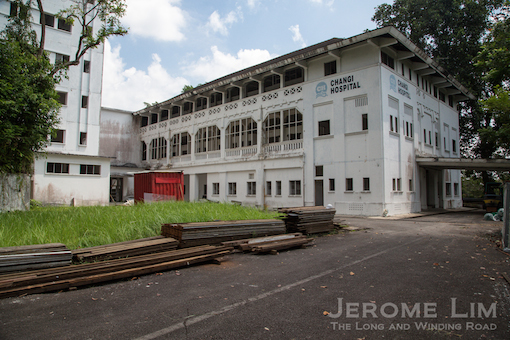
The cluster of buildings reminding us of the former RAF Hospital Changi.
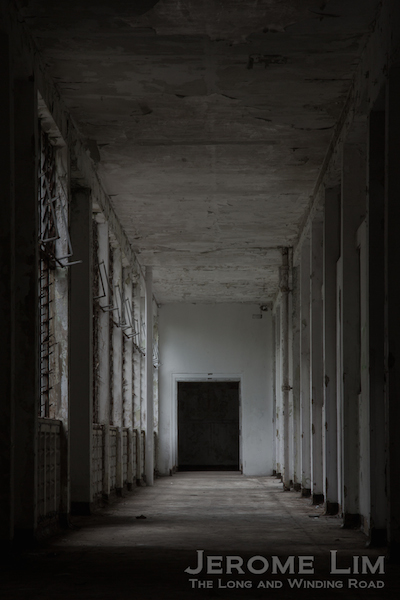
A corridor into the past – a corridor along Block 161 as seen from Block 37.
Several reminders of these episodes in Changi’s history can still be seen today. Buildings from the various barracks from the 1930s and the remnants of the Johore Battery tell us of its garrison days. The air base is still around and although this is hidden from the public eye, a part of the former RAF Changi isn’t, including a cluster of buildings which served as the RAF Hospital Changi. With the permission of the Singapore Land Authority, I managed to wander through the old corridors of the old hospital, which despite what has, in more recent times, been said about it, isn’t what it is made out to be.

The casualty entrance and the operating theatre at Block 37 on top of the hill at the end of Hendon Road.

The operating theatre area.
Perched on the northern slope of the former FEAF Hill overlooking the eastern Johor Strait and surrounded by a sea of greenery, the site of the hospital does seem as ideal as any as a one given to the care and recovery of the infirmed. Standing somewhat forlornly since they were vacated in 1997, the three buildings of the former hospital, now painted by many in a somewhat negative light, a sad reminder of the hospital that was very well thought of by many of its would be patients.

The greenery that surrounds the former hospital site.

A view towards the Johor Strait, Pasir Ris and Punggol from the roof of Block 161.
The hospital’s origins lie with the establishment of the RAF’s Changi Station, or RAF Changi. The construction of an airfield by the Japanese in 1943 in the former army cantonment with the help of labour provided by prisoners-of-war (POW) had unlocked the potential of an area initially deemed unsuitable for an air base. The returning British wasted no time and with help from Japanese POWs built on the initial effort and had Singapore’s third principal RAF station set-up around it in 1946.

An aerial view of the Changi Airfield, the construction of which was initiated by the Japanese in 1943.
RAF Hospital Changi during its time had a reputation of being modern and well equipped. The large maternity ward it boasted of was an indication of the presence of many young military families stationed in Singapore, not just with the RAF, but also in the other armed services. By the time the RAF vacated Changi and the hospital in 1971, the ward was responsible for more than a thousand new arrivals.

What would have been a women’s ward in Block 161.

Another view of the ward.
The hospital’s own arrival came with its setting up in two former barrack buildings. The buildings on Barrack Hill (later FEAF Hill), Blocks 24 and 37, had originally been a part of the pre-war Kitchener Barracks (Block 37 may originally have been a medical facility serving Kitchener Barracks).
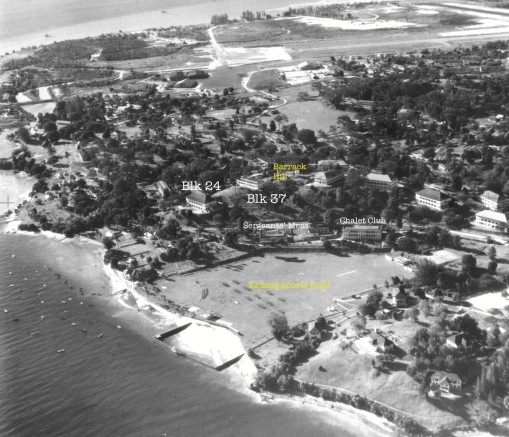
RAF Changi 1950. The relative positions of the original Blks 24 and 37 of RAF Hospital Changi and the Chalet Club can be seen (lkinlin18 on Flickr – license).

Blocks 161 and 24.
The third building we see today, Block 161, was added in 1962. It was constructed to allow the expansion of the hospital after an attempt to consruct a new hospital at Selarang ran into difficulty and was abanadoned. The new building also provided a link over the steep incline that separated the hospital’s original blocks.

A view from Block 24 towards Block 161.

A passageway on the top level of Block 24.
Named after Lord Kitchener, an officer in with the Royal Engineers who perished in service during World War I, Kitchener Barracks was home to the Royal Engineers and was one of four barracks that made up the army garrison. The hospital’s original buildings, the three storey Block 24 in particular, bear resemblance to many other barrack blocks that were built in the same era found across Singapore.

Block 24, which resembles many of the British built barracks blocks from the same era.
The are suggestions that the hospital may have been established before the war, in 1935, around the time the barrack buildings were constructed. This however does not seem to have been likely. The evidence points to RAF Hospital Changi’s being established around 1947 based on records and also mentions of the hospital in newpaper articles.

Another ward in Block 161.

Sanitary facilities.
No mention is also made of the hospital in late 1930s articles reporting to the intention to set up and the opening of the British Military Hospital at Alexandra. These point only to a Military Hospital at Tanglin as having been the only functioning hospital within the British military establishment in Singapore. The first reference to an RAF Hospital was in 1946 when that was set up temporarily in part of the mental hospital at Seletar (what became Woodbridge Hospital).

The bathroom inside the women’s ward.

A corridor in Block 161 leading to Block 37.
One of the notable contributions of the hospital was the role it played in responding to medical emergencies hundred of miles offshore. The participation of the hospital extended to the deployment of “flying” surgeons and other medical personnel, one of whom was S/Ldr Agnes Bartels – who had the distinction of being the RAF’s only woman surgeon stationed in the Far East.

An air-conditioning cooling unit outside Block 161.

On the ground level of Block 24.
The hospital would also called into service during the Korean War. A “Flying Ambulance” service, which was organised by the RAF to repatriate wounded UN Command troops from Japan via the UK to their home countries, used Singapore as a stopover. A ward specially set up at RAF Hospital Changi, allowed the wounded to be cared for whilst in transit. During the period, the hospital saw troops from several countries, which included the likes of Turkey and France.

What seems to be a kitchen in Block 24.
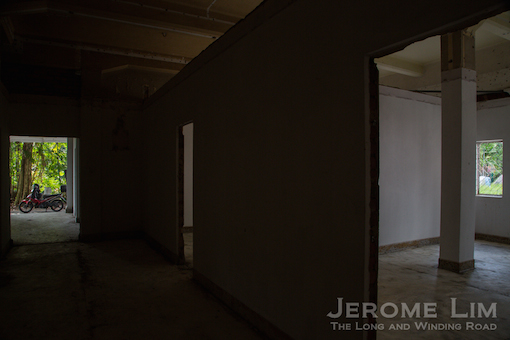
The entrance area at Block 24.
The end for RAF Hospital Changi came in 1971 when the British pulled their forces out, at which point it was one of the three military run hospitals on the island. While the other two, the British Military Hospital (now Alexandra Hospital) and the Naval Base Hospital, were handed over to Singapore, Changi was retained for use as a military hospital to serve the smaller force being deployed under the ANZUK arrangement. On 1 October 1971, the then 150 bed hospital became the ANZUK Military Hospital.

A corridor on the second level of Block 24.

A view from Block 161 towards Block 24.
The withdrawal of Australia from the ANZUK arrangement (which saw a pullout in 1975), placed the hospital once again under the command of the UK military. It was then renamed the UK Military Hospital for a short while before it was handed over to the Singapore Armed Forces (SAF) on 1 December 1975 when it became the SAF Hospital.

A WC in Block 24.

The roof structure of Block 161.

Another corridor in Block 161.
Intended to serve SAF personnel and their families, the hospital was also to open its doors to the public. This was in early 1976, prior to it being transferred to the Ministry of Health who merged it with the nearby 36 bed Changi Chalet Hospital and it became Changi Hospital on 1 July 1976.

Changi Chalet Hospital at Turnhouse Road seen in the mid 1970s (since demolished). The field in the foreground is the former RAF Changi’s Padang Sports Field and is where the former SIA Group Sports Club was built in the 1980s (photograph: Edmund Arozoo on On a Little Street in Singapore).
The decision to set up the 36 bed Changi Chalet Hospital, which was opened in the converted former Chalet Club (between Turnhouse Road and Netheravon Road) in August 1974, only for it to be absorbed into Changi Hospital less than two years later seems rather strange. Opened with the intention to serve “residents in the area”, rumour has it that the well equipped hospital, was set up to serve a certain group of holiday makers in what had been a well protected area.

A view from the old Sergeants’ Mess towards the area where Changi Chalet Club was.
The death knell for Changi Hospital was sounded when it was announced in 1988 that a new site was being sought for a new Changi Hospital, which was “poorly located and not designed orginally to operate as a high activity acute hospital”. That was eventually found in Simei and the new Changi Hospital, which merged the operations of the old Changi Hospital, which closed in January 1997, with that of the former Toa Payoh Hospital, was opened in February 1997.

More views of Block 24.
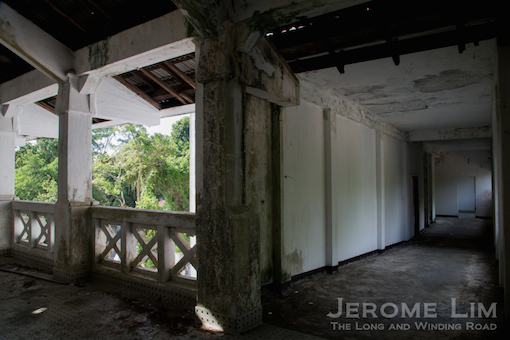
The connection between Block 24 and Block 161.
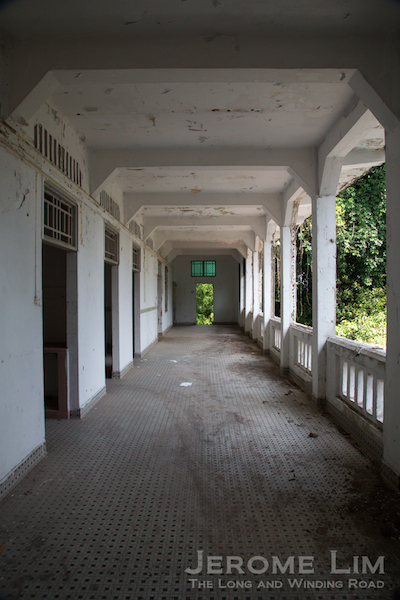
A corridor at Block 37.

Block 37 as seen from Block 161.

Block 37.
The eventual fate of the buildings is not known. A tender exercise conducted in 2006 saw the award of site for interime use on a lease period of three years (extendable to an additional three plus three years) to Premium Pacific Pte Ltd. The intention to convert it into a Spa & Resort Development by 2008 however did not materialise and the property was returned in early 2010. Further attempts to find interim uses for the site have proved unsuccessful and the buildings have, since the hospital’s move, been sadly been left unused.

Block 37.

Block 37.
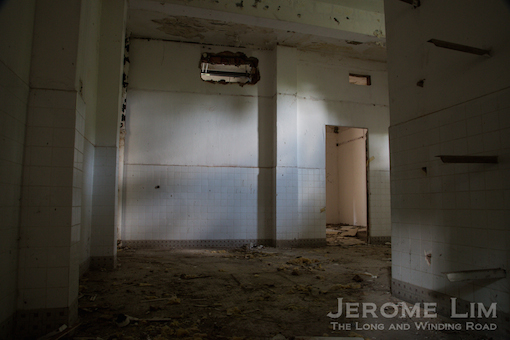
A room in Block 37.

Block 37 towards Block 161.

Block 37.

The staircase down from the second level of Block 37.






































































[…] over 40 beautiful photographs, it is well worth reading A wander through old Changi Hospital from: The Long and Winding […]
Thank you, Jerome! I was one of the thousand or so born in this hospital (in 1963). So it was great to have the chance to see the old place, even in it’s poor condition.
Amazing post!!!
Thanks 🙂
Very interesting blog. I often wondered what happened to that hospital since I was a patient there. I have lived in Singapore as a kid and later in the RAF on No. 52 Squadron. Sadly a car crash badly injured my knee and i had great treatment in Changi hospital but had to return to UK for a while for rehab.
It seems strange to me that, in an island apparently short of space, this area has not been redeveloped.
I was stationed at the hospital from 1969 till October 1971. These pics have brought back many happy memories. Bob b
cant believe how it has been left to rot.i served there from 1973 1976 not to sure of exact dates .Andy Menere 217799 RAAMC
I really enjoyed this wander through RAF Changi Hospital, although sad to see it’s state now. I had a baby there in 1969 & did not believe all this rot about being haunted. You inspired me to go digging further into the history of RAF Changi hospital & I have finally found a book that says it was opened in 1947, ‘Wards in the Sky’ by Mary Mackie, it tells that Maternity was near the beach (block 24) & the 91 steps they had to climb to get to the other part of the hospital, I also found a photo of it from 1950, which shows the 2 separate buildings. Thank you again for inspiring me to keep digging into it.
I went to school in RAF Changi 1948/50 . We lived in the officer’s quarters in Selerang Park, I often wonder what happened to those rather grand houses and if any archive photographs exist.
RAF Changi Hospital where my daughter was born. So sad to see how the abandoned building looked a few years ago when we visited Singapore.
even in this state, looks forlorn yet beautiful
hello! can i check if there’s another round of the tour? i missed the registration!
Hi Jasline, all I can say is that there are no plans at the moment for another around.
I was sad to see how it has just been left..These type of Buildings were so beautiful & Majestic. Thought it may have been restored & made into a Hotel
Thank you for this interesting history and photos of old RAF Changi hospital. My mother was a nurse and midwife there in the early 1950s. I have a great photo of her showing a baby to Lady Mountbatten in one of the wards – the Wilmslow ward!
I have only just come across this. I was born at the hospital in 1955 and went back in 2015 though only saw it from the outside so this was a very interesting read. Thank you
I was born here in May 1962. My dad was stationed at RAF Changi. This was fascinating for me to see inside.